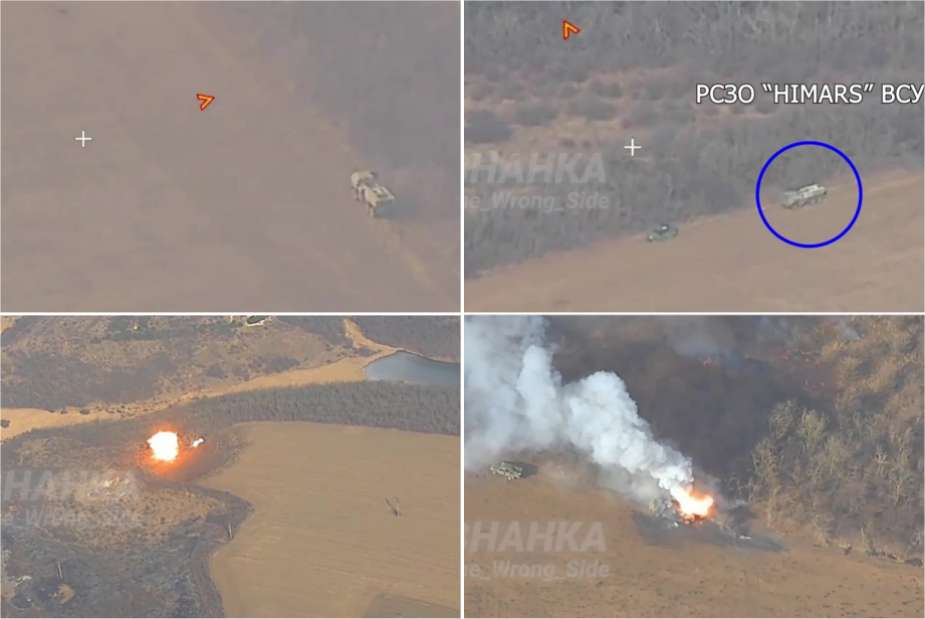On March 5, 2024, several Russian media reported the first confirmed instance of the destruction of a US-supplied M142 High Mobility Artillery Rocket System (HIMARS) in use by the Ukrainian Armed Forces. This event has been verified due to the provision of visual evidence by the Russian Armed Forces, showcasing the aftermath of the attack near the village of Pokrovsk, located approximately 40 kilometers away from the combat line.
Follow Army Recognition on Google News at this link

This first destruction of a US-supplied M142 HIMARS of the Ukrainian Armed Forces has been verified due to the provision of visual evidence by the Russian Armed Forces. (Picture source: Russian social media)
The footage, obtained through a Russian reconnaissance drone, captured the HIMARS positioned openly during daylight, raising questions regarding its stationary status. It is speculated that the Ukrainian military might have been preparing for operations since the launcher was not in the midst of reloading activities. The standard operational procedures for the 27th Rocket Artillery Brigade of Ukraine, which operates these systems, typically involve conducting movements at dawn or dusk to minimize exposure and maintain mobility outside active missions.
The details surrounding the method of the attack indicate that the HIMARS was targeted either by an Iskander-M missile or a 300mm 9M544 high-precision guided missile from a Tornado-S MLRS, deployed in Ukraine since November 2022. The impact was sufficient to cause a fire, leading to the detonation of the solid propellant of an onboard M30/31A1 GMLRS rocket.
This event marks the first time a Russian counterbattery fire has successfully destroyed a HIMARS system, a subject of previous challenges due to the HIMARS's designed mobility and quick deployment capabilities. Nonetheless, the loss represents a minor reduction in the Ukrainian artillery resources. To date, Ukraine has received 39 HIMARS units from the United States, with additional artillery support in the form of 25 M270 systems — which have a similar function but with double the rocket capacity — provided by the United Kingdom, Germany, Italy, and France. Following this incident, Ukraine maintains the vast majority of its artillery assets.
Army Recognition reported on January 2, 2023, that the Russian Southern Front Telegram channel had earlier claimed what was said to be the initial destruction of a US-supplied HIMARS used by the Ukrainian Armed Forces. Nevertheless, the exact degree of damage sustained by this HIMARS unit has not been fully clarified, especially when considering the imagery shared by Astraia Intel on February 11, 2024, which showed a Ukrainian M142 HIMARS with damage being unloaded from an An-124 "Ruslan" aircraft in the United States.
The M142 HIMARS rocket launcher, supplied by the United States to Ukraine, is regarded by Russian soldiers as one of the most dangerous Western-supplied weapons due to its significant role in strengthening the Ukrainian Armed Forces' capabilities.
The HIMARS system is recognized for its strategic advantage, notably its ability to target locations up to 300 kilometers away. This range allows Ukrainian forces to strike various targets, including Russian command centers, fuel and ammunition depots, and other key military assets that are beyond the reach of Russian defensive measures. The ability to target essential military resources such as long-range artillery systems, electronic warfare units, radar systems, and air defense systems has contributed to altering the dynamics on the battlefield in favor of the Ukrainian soldiers.
The deployment of the HIMARS has facilitated a shift in Ukrainian military tactics from attritional warfare to more asymmetric strategies, focusing on exploiting Russian vulnerabilities. This shift includes the ability to target and disrupt Russian logistical channels and supply depots that are critical to the sustainment of military operations. The use of HIMARS has reportedly led to the destruction of numerous Russian supply depots, impacting the logistical support for Russian forces in the region.
Additionally, the precision-guided munitions utilized by the HIMARS system are noted for their ability to minimize collateral damage, which is particularly relevant when targeting areas near civilian populations. This precision has allowed for more targeted strikes against military objectives while mitigating unintended damage to civilian infrastructure. The psychological impact of the HIMARS system on Russian forces, particularly those stationed within its attack radius, has been noted, with implications for morale and operational effectiveness. The system's mobility and rapid deployment capabilities have also been highlighted as factors complicating Russian defensive strategies, as they have been instrumental in maintaining and reinforcing Ukrainian defensive lines against ongoing Russian attacks.
The M142 HIMARS, developed by Lockheed Martin for the United States Army, is noted for its attributes including mobility, precision, and flexibility. The design incorporates a lightweight structure and wheeled configuration, which facilitates rapid deployment and transportability by aircraft, enhancing its operational versatility. The HIMARS system has the capability to launch a variety of munitions, such as the Guided Multiple Launch Rocket System (GMLRS) and the Army Tactical Missile System (ATACMS), enabling engagement with targets up to 300 km away. The primary munition, the M30 GMLRS, utilizes GPS for guidance, aiming for a circular error probable (CEP) of less than 5 meters under optimal conditions. Additionally, the future integration of the Precision Strike Missile (PrSM), which is expected to have a range of approximately 500 kilometers, could potentially augment the defensive postures of regional allies if it were to be provided.
















